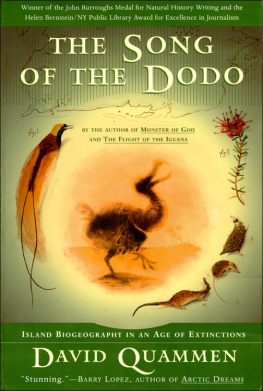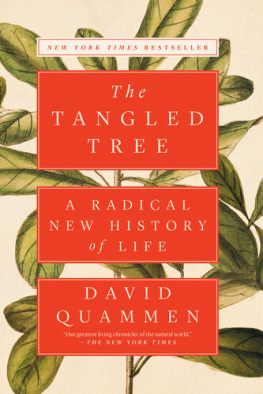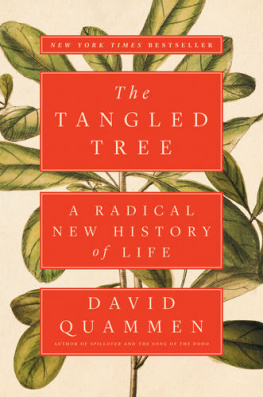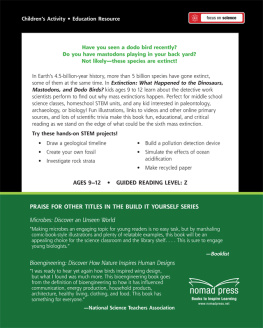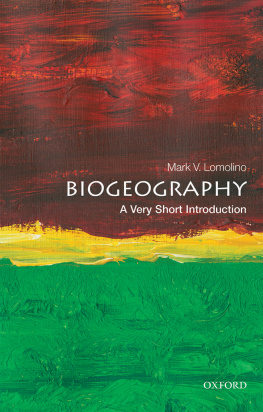David Quammen - The Song of the Dodo: Island Biogeography in an Age of Extinction
Here you can read online David Quammen - The Song of the Dodo: Island Biogeography in an Age of Extinction full text of the book (entire story) in english for free. Download pdf and epub, get meaning, cover and reviews about this ebook. year: 1997, publisher: Scribner, genre: Politics. Description of the work, (preface) as well as reviews are available. Best literature library LitArk.com created for fans of good reading and offers a wide selection of genres:
Romance novel
Science fiction
Adventure
Detective
Science
History
Home and family
Prose
Art
Politics
Computer
Non-fiction
Religion
Business
Children
Humor
Choose a favorite category and find really read worthwhile books. Enjoy immersion in the world of imagination, feel the emotions of the characters or learn something new for yourself, make an fascinating discovery.
- Book:The Song of the Dodo: Island Biogeography in an Age of Extinction
- Author:
- Publisher:Scribner
- Genre:
- Year:1997
- Rating:4 / 5
- Favourites:Add to favourites
- Your mark:
- 80
- 1
- 2
- 3
- 4
- 5
The Song of the Dodo: Island Biogeography in an Age of Extinction: summary, description and annotation
We offer to read an annotation, description, summary or preface (depends on what the author of the book "The Song of the Dodo: Island Biogeography in an Age of Extinction" wrote himself). If you haven't found the necessary information about the book — write in the comments, we will try to find it.
The Song of the Dodo: Island Biogeography in an Age of Extinction — read online for free the complete book (whole text) full work
Below is the text of the book, divided by pages. System saving the place of the last page read, allows you to conveniently read the book "The Song of the Dodo: Island Biogeography in an Age of Extinction" online for free, without having to search again every time where you left off. Put a bookmark, and you can go to the page where you finished reading at any time.
Font size:
Interval:
Bookmark:

IN 1982 a graphic artist named Kris Ellingsen went to graduate school in evolutionary biology and began coming home with the name Robert MacArthur on her lips. MacArthur, who had been dead then just a decade, hovered like an intellectual archangel over the department of which she had become part. I was (and am) lucky enough to be married to Ms. Ellingsen, and those early dinner-table conversations with her about the man whom Edward O. Wilson has called the most important ecologist of his generation were the real beginning of this book. During that period, while I sat in a solitary study writing magazine essays about peculiar animals, she was bringing the revolution in theoretical ecology home from school.
Throughout later years, Kris has remained my first and most trusted scientific consultant and literary sounding board. For all her varied contributions to The Song of the Dodo (including the maps), my gratitude is best expressed privatelyon a daily basis, but especially on wedding anniversaries.
Two other ferociously bright and patient women have also seen this project along its way, providing crucial support, advocacy, and guidance: Rene Wayne Golden and Maria Guarnaschelli. To call them the books godmothers would be only half enough; they are also its obstetricians.
The John Simon Guggenheim Memorial Foundation favored me with a fellowship devoted to this project during the year 1988-1989, making possible (among other things) my first trip to Madagascar. For the Foundations trusting generosity, Im very grateful. Im also grateful to Ann Gudenkauf, Thad Holt, Alan Lightman, Barry Lopez, and David Roe for helping make that first year of work possible.
Tom Lovejoy, Ed Wilson, and Mike Gilpin provided important early encouragement. Special thanks are due also to scientific and literary friends who, near the other end of the process, read the entire manuscript and gave me valuable reactions, criticisms, and suggestions: Tim Cahill, Greg Cliburn, Mike Gilpin again, and Bob Holmes. Two other people have my gratitude for support and encouragement beyond description, crucial to this book and every other one Ive written: Mary and Will Quammen.
Many busy but generous individuals read portions of the manuscript and offered corrections on matters of scientific, historical, and cultural fact. Exuberant thanks on this account to Bob Beck, Rob Bierregaard, Ted Case, Jared Diamond, Owen Griffiths, Willard Heck, Carl Jones, Tom Lovejoy, Russ Mittermeier, William New-mark, Gordon Rodda, Ilse Schreiner, Eleonore Setz, Mark Shaffer, Daniel Simberloff, Ted Smith, Michael Soul, P. J. Stephenson, Karen Strier, Ed Wilson, and Pat Wright. Although the criticisms and suggestions of these expert readers were vastly important in bringing me back on line where I had wobbled off, any lingering mistakes are obviously my own responsibility, not theirs. Gloria Thiede transcribed many hours of taped interviews full of abstruse technical terminology and indecipherable scientific names, saving me weeks of frustration. Chuck West performed an equally precious service, mastering a body of rules and numbers far more arcane than island biogeography in order to keep me aright with the IRS. Jenny Dossin of Scribner not only designed the published book but allowed me the privilege of advice and consent. Katya Rice gave her fine eye to the copyediting. Susan Moldow, Roz Lippel, Tysie Whitman, Nan Graham, Sharon Dynak, John Fontana, Maria C. Hald, and many others of the Scribner crew, as well as Mike Jacobs, Larry Norton, Marie Florio, and their colleagues at the umbrella entity, Simon & Schuster, have been valued collaborators. Walton Fords jacket art captured beautifully the lost, wondrous bird that dances in my minds eye too. For the glossary, I have drawn especially on the guidance of Art (1993), Brown and Gibson (1983), MacArthur and Wilson (1967), Mayr (1991), Shafer (1990), Steen (1971), and Wilson (1992).
Im also deeply indebted to the scientists and fieldworkers (some but not all of whom Ive already mentioned) who welcomed me into their offices, their field camps, their homes, in some cases their lives; who shared their publications, their food, occasionally even their data; who indulged me to explore their work and their thoughts. Again alphabetically: Bob Anderson, David Baum, Bob Beck, Peter Becker, Rob Bierregaard, Todd Bishop, Doug Bolger, Ted Case, Jodie Carter, Paul Conry, James Cook, Peggy Cymerys, Patrick Daniels, Jared Diamond, Hugues Ducenne, Tom Fritts, R. Gajeelee, Mike Gilpin, R. H. Green, Owen and Mary Ann Griffiths, Sue Haig, David Hau, Willard Heck, Jon Herron, Roger Hutchings, Jim Johnson, Alison Jolly, Carl Jones, Michael Jones, Valerie Kapos, Dick Knight, Linda Laack, Olivier Langrand, Richard Lewis, Tom Lovejoy, Dave Mattson, Mike McCoid, Andy Mack, Debra Wright Mack, David Maehr, Adina Merenlender, David Meyers, Don Nafus, William Newmark, Martin Nicoll, Deborah Oberdorff, Sheila OConnor, Mark Pidgeon, Ray Radtkey, Chris Ray, Gordon Rodda, Jungle Jim Ryan, Hal Salwasser, Ilse Schroff, Use Schreiner, Herbert Schubart, Chris Servheen, Eleonore Setz, Mark Shaffer, Dan Simberloff, Andrew Smith, M. Noor Soetawijaya, Michael Soul, Patricia Spyer, P. J. Stephenson, Wendy Strahm, Karen Strier, Michael Tewes, Bas van Balen, Bas van Helvoort, Eduardo Veado, David Western, Gary Wiles, Ed Wilson, Summer Wilson, Michael Winslett, Marina Wong, and last again but never least, Pat Wright.
And there were the other good souls whose various acts of trust and generosity helped me along the pathways of travel and research. In addition to those whose contributions are described in the text: Philip and Sue Adlard, Caroline Alexander, Joseph Andrianjaka, Loretta Barrett, Dick Bergsma, Peter Brussard, Victor Bullen, Larry Burke, George Butler, Mark Bryant, Kerry Byrd, Matthew Childs, Liz Claiborne, Doug Crichton, Larry Dew, Andrew Dobson, Uta Henschell, Michael H. Jackson, Mark Jaffe, Amy Kemmerer, Frans Lanting, Lewis Lapham, James D. Lazell, Jr., Les Line, Rod Mast, Bob Mecoy, Pascale Moehrle, Jim Murtaugh, Nick Nichols, Grace OConnor, Art Ortenberg, Mary Pearl, John Peck, Hallie and Charles Rabenarivo, Emil Rajeriarison, Loret Rasabo, Solomon Razafindratandra, Alison Richard, Bill Roberson, Yvonne Rush, George Schatz, Gary Soucie, Rudy Specht, Effendy Sumardja, Ian Thornton, Simon Tonge, Makarim Wibisono, Todd Wilkinson, Amanda Wright, Steve Zack, and Charles Zerner. And to still other folk who helped me materially and whose names have momentarily and regrettably leaked from my porous memory: thanks and sorry.
The young Malagasy man identified here as Bedo, and known more formally as Joseph Rabeson, falls in a special category; I cant begin to thank him for what he gave to this story because, besides giving the song of the indri, he gave his life. Im deeply obliged to his family membershis father, Jaosolo Besoa, his brother, Maurice, his sister, Eugeniefor entrusting me with some personal memories and some glimpses of their anger and grief.
Also in a special category is my faithful friend, interpreter, and traveling companion for Indonesian journeys, 1. Nyoman Wirata. Terima kasih.

THIS IS a book of diagnosis, not of prescription. Some readers, I hope, will want more. I foresee a farther question arising in their minds: What can we do about it?
The question is simple, but unfortunately theres no simple answer. If a solution exists to this complicated set of problemslandscape fragmentation, insularization of species, small-population jeopardies, extinction, ecosystem decaythat solution cant be sketched on a thumbnail. Certain mitigating measures offer some promise of helping us avert the future were presently headed toward, which is a future of soul-withering biological loneliness. But to do justice to the range of those measures, in their scientific and political complexity, would take another book. All I can do here is point toward several useful publications that address various aspects of the What can we do about it? question from various angles.
Next pageFont size:
Interval:
Bookmark:
Similar books «The Song of the Dodo: Island Biogeography in an Age of Extinction»
Look at similar books to The Song of the Dodo: Island Biogeography in an Age of Extinction. We have selected literature similar in name and meaning in the hope of providing readers with more options to find new, interesting, not yet read works.
Discussion, reviews of the book The Song of the Dodo: Island Biogeography in an Age of Extinction and just readers' own opinions. Leave your comments, write what you think about the work, its meaning or the main characters. Specify what exactly you liked and what you didn't like, and why you think so.

